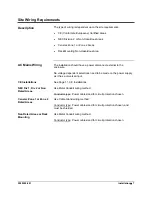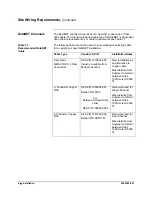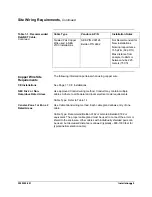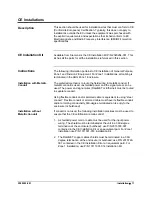
Site Wiring Requirements,
Continued
Use approved flexible non-metallic conduit wiring method. Conduit may
contain multiple cables. For CE installations use only cable gland wiring
method.
Non-Hazardous Areas or
Rack Mounting
Cable Type: Recommend Belden 9182 or equivalent. Other cables with
individually shielded pairs can be used, but decreased distance is
allowed (typically ~800-1000 feet for typical instrumentation cable).
DataNET Fiber Optic
Cable Connections
The DataNET channel connections can be either copper wire or fiber
optic cable. The wiring method and cable type for DataNET is dependent
upon the site requirements. The following pertains when using copper
wire.
See Page 11, CE Installations.
CE Installations
Use approved Conduit wiring method. Conduit may contain multiple
cables. Adhere to all Federal and local electrical code requirements.
NEC Div 2 or Non-
Hazardous Areas
Cable Type: Duplex fiber, 62.5/125 micron; see Table 2-1.
Connection: Type ST fiber connectors. Connect these to the appropriate
transmitter and receiver ports for the respective channel.
Use Cable Gland wiring method. Each cable gland allows entry of one
duplex fiber cable.
Cenelec Zone 1 or Zone 2
Rated Areas
Cable Type: Duplex fiber, 62.5/125 micron.
Connections: Type ST fiber connectors. Connect these to the
appropriate transmitter and receiver ports for the respective channel.
Use approved flexible non-metallic conduit. Conduit may contain multiple
cables. Conduit may contain multiple. This method is suitable for CE
installations.
Non-Hazardous Areas or
Rack Mounting
Cable Type: Duplex fiber, 62.5/125 micron.
Connection: Type ST fiber connectors. Connect these to the appropriate
transmitter and receiver ports for the respective channel.
10
•
Installation
2000592-001
















































